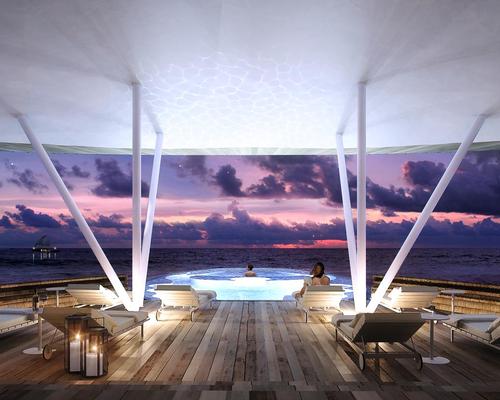06 Jul 2016
Over-water Iridium Spa at upcoming St Regis Maldives to feature dramatic oceanside hydrotherapy pool
BY Jane Kitchen

The 77-villa St Regis Maldives Vommuli Resort is set to open in September, complete with a 2,000sq m (21,528sq ft) Iridium Spa that includes one of the biggest salt water hydrotherapy pools in the Maldives.
The hydrotherapy pool, named The Blue Hole pool, will accommodate up to 12 guests, and looks out on the Indian Ocean. A combination of Maldivian sea salt, heat, and pressure from the water is designed to stimulate both the senses and the immune system, and to aid in digestion, improve blood flow, reduce stress hormones and lessen the body’s sensitivity to pain.
The over-water spa will also include six couples’ treatment suites, including two dedicated to ayurveda treatments, all of which have ocean-facing bathtubs. A relaxation room as well as male and female steamrooms, sauna and cold drench showers are also featured, as well as a retail boutique with Natura Bisse skincare products.
Designed by Singapore-based WOW Architects, the St Regis Maldives Vommuli Resort was short-listed for the World Architecture Festival Awards last year.
In a statement, the firm said they “chose to delight the senses through education, creating awareness, and new paradigms of interacting with the physical environment.
“Here, paradise is emotionally and intellectually experienced and enjoyed, but with a profound awareness of the complex relationships of the ecosystems being inhabited,” the statement continued.
WOW designed the resort with several distinct ecological zones – lagoon, beach, coastal and jungle – which each have unique anchoring activities. The Lagoon Zone features a water amphitheatre along with the Iridium Spa, while the Jungle Zone has a nature discovery centre.
The landscaping has a simple concept of conserving the existing flora and fauna and replacing displaced plant material with locally-sourced species from neighbouring islands, as well as the introduction of selective fruit trees, herbs and salt-resistant plants for the edible garden and nature discovery trail.
The architectural forms and spaces are inspired by nature, and include variations of the primitive hut in a nod to the island’s origins.
Close Window